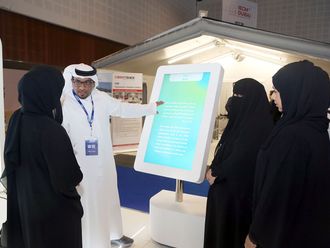On display in Dubai, 20 fibreglass camels painted by artists from 20 countries form part of a unique charity campaign
These are just some of the20 camelsdesigned to herald the arrival of the Camel Caravan. Each of the two feet high and three feet long fibreglass camels represents a country that is a neighbour or a trading partner of the UAE and has been painted by an artist from that country.
"This is just the beginning. Soon, Dubai will be converted into an open-air art gallery with 200 colourful, life-size camels installed in the city's streets and squares. The spirit of the Camel Caravan is to merge entertainment, art and commerce while benefitting charity and the community," say Kenneth and Patricia Palmer, of ArtWorks, organisers of the event. "Patricia is an artist and I am a banker. We love Dubai and wanted to do something for this city, so we decided to pool our talents to organise this event. And this is certainly much more fun than banking," says Kenneth.
The idea for this project was inspired by the Cow Parade that was first held in Switzerland in 1998. It has been successfully replicated in other cities with a Bear Parade in Berlin, a Moose Parade in Toronto and others featuring fish, flamingoes, horses and kangaroos. "The camel was the obvious choice for the UAE," says Patricia.
Patricia and Kenneth Palmer, organisers of the Camel Caravan. ©Gulf News |
Sponsorship is being invited from companies, institutions and community organisations. The sponsorswill choose from the portfolio of designs submittedby artists and their chosen artist will be commissioned to paint their camel. The sponsor's logo or name will be displayed on the base of the camel and they can use images of their camel in their advertising and promotions. "The painting will be done in the Camel Barn, an air-conditioned wedding tent to be set up at the Creekside Park. Because many artists maybe unfamiliar with painting on a three-dimensional fibreglass object, experts will beon hand to guide them on techniques. It will be a public event, where people can come and watch the artwork in progress and interact with the artists," says Kenneth.
After the camels are painted, they will be put on display in the grassy areas of the Creekside Park. In December, they will be moved to various locations in the city. "You will see them on sidewalks, on roundabouts and in the most unexpected places all over the city. The camels have been designed to be weather proof and the public will be encouraged to touch and feel the art," says Patricia.
"This is public art in the truest sense of the term and it would not have been possible without the support of Dubai Municipality. We are also grateful to the Rotary Club of Dubai for their patronage," adds Kenneth.
Finally, in March, the camels will be auctioned for charity. "We plan to have an Internet auction as well as radio, television and public auctions. The proceeds will go to various children's charities and towards the development of art and culture in the UAE. The sponsor of each camel will choose the charity that should benefit from its sale," explains Ken.
From left: Dirk van Wyk with his camel 'From Sea to Sea', Pinky Shah with her camel 'Pavanvegh Saandhini', Khalil Abdul Wahid with his camel 'Bastakiya' and Rin Colabucci with her camel 'Camelsan'. ©Gulf News |
Twenty artists from 20 different countries have already had a taste of painting camels. Some of them shared their experiences with Tabloid.
• Pinky Shah: I am a sculptor, so found it easy to paint the camel. In India camels are found in the states of Gujarat and Rajasthan, so I chose a bandhini pattern, which is typical of the handwoven textiles of these states.
I embellished my bright red camel with mirrors, tassels around its knees and a bell around its neck, just as camel owners in India do. My camel is called Pavanvegh Saandhini, which means "as fast as the wind". I teach at the Dubai International Art Centre and our members are excited about this event and many will participate in it.
• Rin Colabucci: A camel is quite alien to Japan, so at first I was a little confused. But later I realised that as an expatriate living in the UAE, the local culture and the camel has become part of my consciousness. So my 'Camelsan' is a mix of both cultures. The blue swirls on its legs depict the ocean around Dubai, while the floral patterns on its body are adapted from designs that you would find on kimonos. The Japanese sandals on its hooves added an element of humour to my artwork. The idea of painting a camel sounds limiting, but I have realised that it has unlimited artistic potential if you let yourself go.
• Khalil Abdul Wahid: Camels are an important part of life in the UAE. So for me the challenge was how to make my camel different and yet representative of the UAE. I decided to decorate it with motifs from traditional UAE architecture. My camel is called Bastakiya, because I have painted windows, doorways and wind-towers that I have seen in my parents' home in the Bastakiya area of Dubai. The colours I have used are









